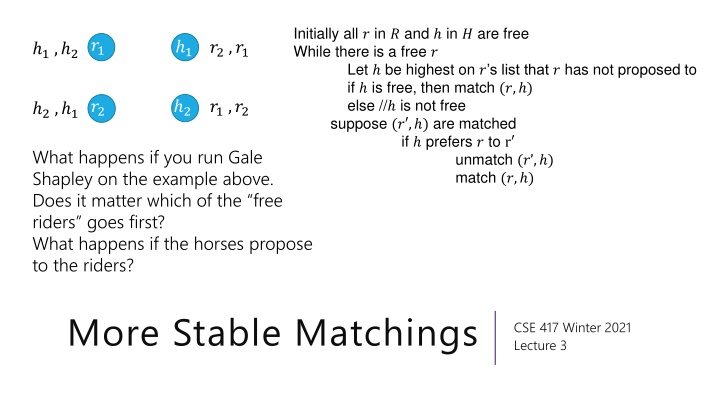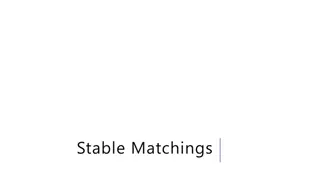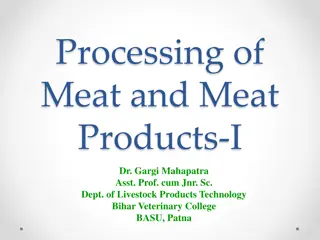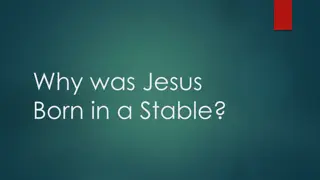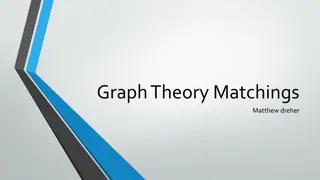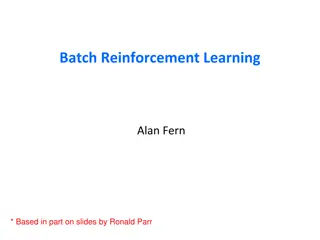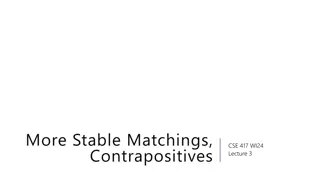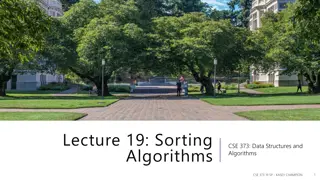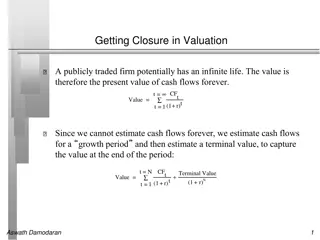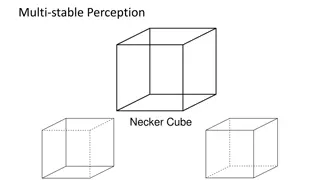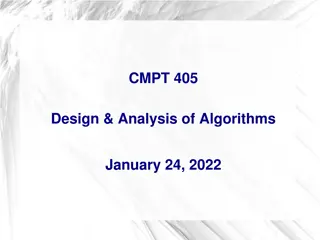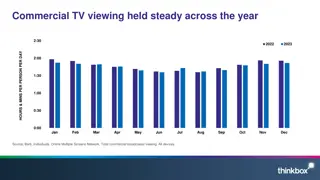More Stable Matchings
The provided content describes the application of a matching algorithm, specifically Gale Shapley, on a given scenario. Initially, all individuals are free to propose. If a free individual exists, they propose to their preferred partner who also prefers them. If not free, individuals reassess their matches until all are paired optimally. Running Gale Shapley on the example yields specific matching outcomes based on preferences and proposals.
Download Presentation

Please find below an Image/Link to download the presentation.
The content on the website is provided AS IS for your information and personal use only. It may not be sold, licensed, or shared on other websites without obtaining consent from the author.If you encounter any issues during the download, it is possible that the publisher has removed the file from their server.
You are allowed to download the files provided on this website for personal or commercial use, subject to the condition that they are used lawfully. All files are the property of their respective owners.
The content on the website is provided AS IS for your information and personal use only. It may not be sold, licensed, or shared on other websites without obtaining consent from the author.
E N D
Presentation Transcript
Initially all ? in ? and in ? are free While there is a free ? Let be highest on ? s list that ? has not proposed to if is free, then match (?, ) else // is not free suppose (? , ) are matched if prefers ? to r unmatch (? , ) match (?, ) ?1 1 ?2 ,?1 1 , 2 ?2 2 ?1 ,?2 2 , 1 What happens if you run Gale Shapley on the example above. Does it matter which of the free riders goes first? What happens if the horses propose to the riders? More Stable Matchings CSE 417 Winter 2021 Lecture 3
Announcements If the news was overwhelming this week, you re not alone on that. You can watch asynchronously if you need to. This week s canvas quizzes delayed to Wednesday. Starting (sometime) next week, we ll use preassigned breakouts (so you don t have to introduce yourself every time). Announcement coming on Ed today. Please follow directions even if you re usually even if you re usually asynchrounous asynchrounous. .
Goals for Today Does it matter which free rider we choose? Does it matter what order How many stable matchings can there be? What can one do in practice? At the end: Introduction to induction.
Multiple Stable Matchings Suppose we take our algorithm and let the horses do the proposing instead. ?1 1 ?2 ,?1 1 , 2 ?2 2 ?1 ,?2 2 , 1 We got a different answer What does that mean?
Proposer-Optimality Some agents might have more than one possible match in a stable matching. Call these people the feasible partners. When there s more than one stable matching, there is a tremendous benefit to being the proposing side. Proposer-Optimality Every member of the proposing side is matched to their favorite of their feasible partners.
Proposer-Optimality Proposer-Optimality Every member of the proposing side is matched to the favorite of their feasible partners. ? ? Let s prove it again by contradiction Suppose some rider is not matched to their favorite feasible partner. Then some ? must have been the first first to be rejected by their favorite feasible partner, . (Observation A) And there is an ? that (temporarily) matched to causing that rejection. Let ? be a stable matching where ?, are matched. The rider ? is matched to some . What can we say about ? ? They had never been rejected by a feasible partner. So they prefer to . And prefers ? to ? (by the run of the algorithm). But then (? , ) are a blocking pair in ? ! ? ?
Implications of Proposer Optimality Proposer-Optimality Every member of the proposing side is matched to their favorite of their feasible partners. We didn t specify which rider proposes when more than one is free Proposer-optimality says it doesn t matter! You always get the proposer-optimal matching. So what happens to the other side?
Chooser-Pessimality A similar argument (it s a good exercise!), will show that choosing among proposals is a much worse position to be in. Chooser-Pessimality Every member of the choosing (non-proposing) side is matched to their least favorite of their feasible partners.
Some More Context and Takeaways Stable Matching has another common name: Stable Marriage The metaphor used there is men and women getting married. When choosing or analyzing an algorithm think about everyone involved, not just the people you re optimizing for; you might not be able to have it all. Stable Matchings always exist, and we can find them efficiently. The GS Algorithm gives proposers their best possible partner At the expense of those receiving proposals getting their worst possible.
How Many Stable Matchings? We ve seen there is always at least one stable matching. We ve seen sometimes there are at least two stable matchings. Can there be only one? Can there be more than two (i.e. can there be stable matchings not found by Gale-Shapley?) Why do we care? GS advantages one side or the other. If other matchings are available, maybe those are more balanced
More than two? ?1 1 ?2 ,?1,?3 1 , 2, 3 ?2 2 2 , 1, 3 ?3 ,?1,?2 3 3 , 2, 1 ?3 ?1 ,?3,?2
What about when ? increases? Ok, ok, is 3 the maximum? What we really care about is: As ? increases, can the number of stable matchings grow quickly enough that it s not possible to examine them all? How do we justify that. I can t just give you one instance I need to give you a family family of instances. Instructions Instructions so that you can build an instance for larger and larger ?.
What about when ? increases? Generalize the idea from the last slide. ?1 has list: 1, 2, 3, , ? ?? has their list start ?, ? ?, ?+1 (for ? > 1) ? has its list start: ??+1,?1,?? (for ? < ?) ? has its list start: ?1,rn
What about when ? increases? Rider optimal: match ?? to ? ?1 1 ?2 ,?1,?3 1 , 2, 3, 4, , ? Switch (?1, 2)(?2, 1) Still stable -- s that changed got happier, no new blocking pairs created. ?2 2 2 , 1, 3 ?3 ,?1,?2 ?2 3 3 , 2, 4 For some ?: Match (?1, ?) Up to ?: (??, ? 1) After ?:(??, ?) Still stable (for same reason) ?4 ,?1,?3 At the end: Match (??, ? 1) and (?1, ?) Still stable (for same reason) ?? ? ? , ? 1, ?+1 ??+1 ,?1,?? ? ? , ? 1 ?? ?1 ,??
How high can that go? One of your homework problem asks you to show that the number of stable matchings can grow exponentially. i.e. there are stable matching instances with ? riders and ? horses with ?? stable matchings (where ? > 1). The exact maximum is unknown!
When theres more than two Can we find them all? Well we could just check all ?! possible matchings to see if each is stable. That s only ?(?! ?2) time. That s really slow. There s a better way! There s an algorithm that runs in ?(?2+ ??) time to print all ? possible stable matchings. Beyond the scope of this course,
If we can find them all could we just find the median one? It s not clear what median means. There is a reasonable definition (ask Robbie after) but it s NP-hard to find the median matching What does that mean: set a reasonable expectation you shouldn t expect to always find the median stable matching (but you can sometimes!)
Can there be only one? If Gale-Shapley returns the same matching regardless of which side proposes, then there must be only one stable matching. Proof: For every agent, when it proposes, it gets its favorite feasible partner (proposer-optimality) and when it chooses, it gets its least favorite feasible partner (chooser-pessimality). So if that agent is the same, it only has one feasible partner. If every agent has only one possible feasible partner, then there is only one possible stable matching. Can we make an example like that? Yes! ?? and ? have each other as first choices for all ?.
So what should you do? Choosing a GS run could give a significant advantage to one side, but Sometimes the advantage is minimal. The NRMP changed from a hospital-proposing based algorithm to a resident-proposing based algorithm. Only about 0.1% of residents got a different assignment when the algorithm changed. In practice, there might be few enough stable matchings to just see them all and pick one (on average, there are only O(?log?) stable matchings).
Induction We proved that Gale-Shapley produces a matching with no blocking pairs with proof by contradiction. We could also have used proof by induction. Induction is useful when you have a claim that is true step-by-step Our big goal is no blocking pairs at all step-by-step, we can say: After ? iterations of the while-loop of GS, there are no blocking pairs among (tentatively) matched agents. i.e. no pairs where both both agents are tentatively matched.
Induction Show a claim step-by-step. Base Case show the calculation starts in the right place (usually that variables store the right values, or some property is true about what we ve calculated so far). If the variables are right before step ?, then they are right after step ?. inductive hypothesis if our property is true before step ? inductive step then it is still true after step ?.
Induction Prove a loop does the right thing. Prove recursive code works Before the loop starts, everything is right. Each time through, if the variables start with the right information, then they are updated correctly. The base case of the recursion produces the right value. If the recursive calls we make produce the right value, then we return the right value. Therefore, after we exit the loop, we have the right answer. Therefore, the first recursive call also produces the right answer.
Induction in 5 easy(?) steps 1. Define ?(?). State that your proof is by induction on ?. 2. Base Case(s): Show the smallest value ?(????) is true. 3. Inductive Hypothesis: Suppose ? ???? ? ????+ 1 ?(?) for an arbitrary ? ????. (The smallest value of ? assumes all nothing else) 4. Inductive Step: Show ? ? + 1 (i.e. get [P(b??? ? ? ] ?(? + 1)) 5. Conclude by saying ? ? is true for all ? ???? by the principle of induction. all bases cases, but
Things to check for ?(?) should: 1. be Boolean valued (i.e. output true or false) 2. Take in an integer. 3. If you knew ?(?) holds for all ?, you should know your main claim. If your inductive step goes back exactly ? steps every time, then you need ? base cases. (good rule of thumb: if you re analyzing recursive code with multiple base cases, your induction proof needs multiple base cases) Be careful with your IH! You want to suppose everything from the base case(s) up to some fixed value ?.
Claim: Gale-Shapley produces a matching without blocking pairs ?(?) after ? iterations of the while-loop of GS, there are no blocking pairs among (tentatively) matched agents. Base Case: After 0 iterations no one is matched, so there are no blocking pairs among tentatively matched agents (because there aren t any). IH: Suppose that after each of the first ? iterations of the while-loop of GS, there are no blocking pairs among (tentatively) matched agents. IS: Want to show after the ? + 1st iteration, there are no blocking pairs among tentatively matched agents.
Claim: GS produces a matching without blocking pairs IH: Suppose that after each of the first ? iterations of the while-loop of GS, there are no blocking pairs among (tentatively) matched agents. IS: Want to show after the ? + 1st iteration, there are no blocking pairs among tentatively matched agents. Proposal Rejected OR Proposal accepted because preferred ? to its previous tentative match OR Proposal accepted because first one received
Claim: GS produces a matching without blocking pairs IH: Suppose that after each of the first ? iterations of the while-loop of GS, there are no blocking pairs among (tentatively) matched agents. IS: Want to show after the ? + 1st iteration, there are no blocking pairs among tentatively matched agents. During the ? + 1st iteration, we have one proposal from a rider ?. If ?is rejected, the matching doesn t change, so there are no blocking pairs by inductive hypothesis. OR proposal accepted because preferred ? to previous tentative match. OR proposal accepted because first one received
Claim: GS produces a matching without blocking pairs IH: Suppose that after each of the first ? iterations of the while-loop of GS, there are no blocking pairs among (tentatively) matched agents. IS: Want to show after the ? + 1st iteration, there are no blocking pairs among tentatively matched agents. During the ? + 1st iteration, we have one proposal from a rider ?. If ?is rejected, the matching doesn t change, so there are no blocking pairs by inductive hypothesis. Otherwise, ? is tentatively matched to . We claim ?doesn t form a blocking pair: since it proposed to , any horse it prefers to already rejected it, so by Observation C, they prefer their partner to ?. And won t form a blocking pair either if it was matched, by IH it preferred its former match to any other tentative match. And it just decided it prefers ?. OR proposal accepted because first one received
Claim: GS produces a matching without blocking pairs IH: Suppose that after each of the first ? iterations of the while-loop of GS, there are no blocking pairs among (tentatively) matched agents. IS: Want to show after the ? + 1st iteration, there are no blocking pairs among tentatively matched agents. During the ? + 1st iteration, we have one proposal from a rider ?. If ?is rejected, the matching doesn t change, so there are no blocking pairs by inductive hypothesis. Otherwise, ? is tentatively matched to . We claim ?doesn t form a blocking pair: since it proposed to , any horse it prefers to already rejected it, so by Observation C, they prefer their partner to ?. And won t form a blocking pair either if it was matched, by IH it preferred its former match to any other tentative match. And it just decided it prefers ?. If it wasn t matched, it hadn t received a proposal from any matched rider, the matched riders all prefer their current matches, so it can t form a blocking pair with them.
Wrapping up the proof By the principle of induction, ?(?) holds for all ?. In particular, after the last iteration of the while-loop of GS, there are no blocking pairs among (tentatively) matched agents. Since we also produce a perfect matching, there are no blocking pairs at all! So we produce a stable matching.
Want more induction practice? Lots of practice materials on the webpage. Look at the resources tab.
